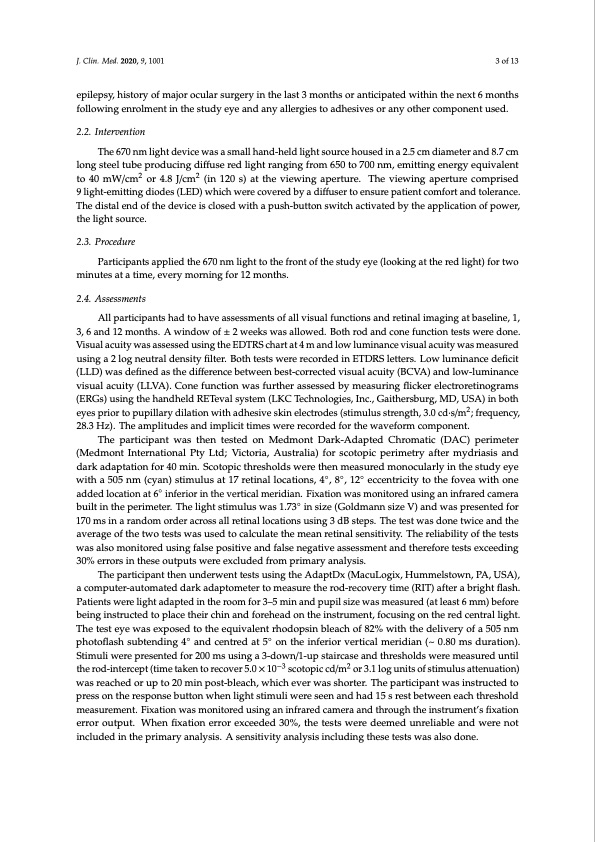
PDF Publication Title:
Text from PDF Page: 003
J. Clin. Med. 2020, 9, 1001 3 of 13 epilepsy, history of major ocular surgery in the last 3 months or anticipated within the next 6 months following enrolment in the study eye and any allergies to adhesives or any other component used. 2.2. Intervention The 670 nm light device was a small hand-held light source housed in a 2.5 cm diameter and 8.7 cm long steel tube producing diffuse red light ranging from 650 to 700 nm, emitting energy equivalent to 40 mW/cm2 or 4.8 J/cm2 (in 120 s) at the viewing aperture. The viewing aperture comprised 9 light-emitting diodes (LED) which were covered by a diffuser to ensure patient comfort and tolerance. The distal end of the device is closed with a push-button switch activated by the application of power, the light source. 2.3. Procedure Participants applied the 670 nm light to the front of the study eye (looking at the red light) for two minutes at a time, every morning for 12 months. 2.4. Assessments All participants had to have assessments of all visual functions and retinal imaging at baseline, 1, 3, 6 and 12 months. A window of ± 2 weeks was allowed. Both rod and cone function tests were done. Visual acuity was assessed using the EDTRS chart at 4 m and low luminance visual acuity was measured using a 2 log neutral density filter. Both tests were recorded in ETDRS letters. Low luminance deficit (LLD) was defined as the difference between best-corrected visual acuity (BCVA) and low-luminance visual acuity (LLVA). Cone function was further assessed by measuring flicker electroretinograms (ERGs) using the handheld RETeval system (LKC Technologies, Inc., Gaithersburg, MD, USA) in both eyes prior to pupillary dilation with adhesive skin electrodes (stimulus strength, 3.0 cd·s/m2; frequency, 28.3 Hz). The amplitudes and implicit times were recorded for the waveform component. The participant was then tested on Medmont Dark-Adapted Chromatic (DAC) perimeter (Medmont International Pty Ltd; Victoria, Australia) for scotopic perimetry after mydriasis and dark adaptation for 40 min. Scotopic thresholds were then measured monocularly in the study eye with a 505 nm (cyan) stimulus at 17 retinal locations, 4◦, 8◦, 12◦ eccentricity to the fovea with one added location at 6◦ inferior in the vertical meridian. Fixation was monitored using an infrared camera built in the perimeter. The light stimulus was 1.73◦ in size (Goldmann size V) and was presented for 170 ms in a random order across all retinal locations using 3 dB steps. The test was done twice and the average of the two tests was used to calculate the mean retinal sensitivity. The reliability of the tests was also monitored using false positive and false negative assessment and therefore tests exceeding 30% errors in these outputs were excluded from primary analysis. The participant then underwent tests using the AdaptDx (MacuLogix, Hummelstown, PA, USA), a computer-automated dark adaptometer to measure the rod-recovery time (RIT) after a bright flash. Patients were light adapted in the room for 3–5 min and pupil size was measured (at least 6 mm) before being instructed to place their chin and forehead on the instrument, focusing on the red central light. The test eye was exposed to the equivalent rhodopsin bleach of 82% with the delivery of a 505 nm photoflash subtending 4◦ and centred at 5◦ on the inferior vertical meridian (~ 0.80 ms duration). Stimuli were presented for 200 ms using a 3-down/1-up staircase and thresholds were measured until the rod-intercept (time taken to recover 5.0 × 10−3 scotopic cd/m2 or 3.1 log units of stimulus attenuation) was reached or up to 20 min post-bleach, which ever was shorter. The participant was instructed to press on the response button when light stimuli were seen and had 15 s rest between each threshold measurement. Fixation was monitored using an infrared camera and through the instrument’s fixation error output. When fixation error exceeded 30%, the tests were deemed unreliable and were not included in the primary analysis. A sensitivity analysis including these tests was also done.PDF Image | Effects of 670 nm Photobiomodulation in Macular Degeneration

PDF Search Title:
Effects of 670 nm Photobiomodulation in Macular DegenerationOriginal File Name Searched:
A_Pilot_Study_Evaluating_the_Effects_of_670_nm.pdfDIY PDF Search: Google It | Yahoo | Bing
Cruise Ship Reviews | Luxury Resort | Jet | Yacht | and Travel Tech More Info
Cruising Review Topics and Articles More Info
Software based on Filemaker for the travel industry More Info
The Burgenstock Resort: Reviews on CruisingReview website... More Info
Resort Reviews: World Class resorts... More Info
The Riffelalp Resort: Reviews on CruisingReview website... More Info
| CONTACT TEL: 608-238-6001 Email: greg@cruisingreview.com | RSS | AMP |